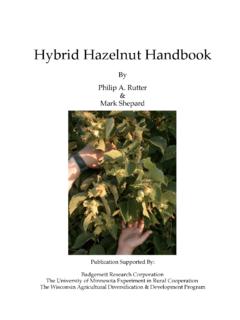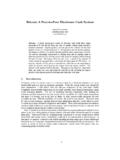Transcription of International Handbook on Forest Fire Protection
1 International Handbook on Forest fire Protection Technical guide for the countries of the Mediterranean basin MINIST RE DE. L'AM NAGEMENT DU. TERRITOIRE ET DE. L'ENVIRONNEMENT. (FRANCE). (FOOD AND. AGRICULTURE. D partement Gestion des territoires ORGANIZATION OF THE. UNITED NATIONS). Division Agriculture et For t M diterran ennes Groupement d'Aix en Provence Le Tholonet - BP 31. 13612 Aix en Provence cedex 1. France i ii iii iv Preface Forest res represent a considerable threat to the Mediterranean forests. It is estimated that about 50,000 res occur each year in the Mediterranean basin and affect more than 600,000 ha. To face this permanent threat, the Mediterranean countries have mobilized and organized for a long time increasingly ef cient Forest re prevention and suppression systems.
2 Thus, gradually, according to their culture, their means and their national preferences, the Mediterranean countries have developed a considerable knowledge, tools and adapted methodologies, typical for each country. Unfortunately, this information remains scattered and is even sometimes not written down. The exchange of information and experiences between countries constitute an effective mean to contribute to the reinforcement of Forest re prevention and suppression. Handbooks of great utility were already elaborated on Forest res, such as for example the Technical Guide written in 1989 by French Mediterranean foresters from Cemagref (France), a public research institute of for agriculture and environment, or the Handbook on Forest re control, a guide for trainers , published by the Finnish organisation for International development (FINNIDA, Finland) in 1993.
3 But these publications, either do not re ect the special problems of the Mediterranean basin, or restrict themselves to only one country, not taking into account regional diversity. Thus, under the in uence of the network for Forest re Protection of the FAO Committee on Mediterranean Forestry Questions of the FAO Silva Mediterranea and thanks to the nancial support of France, in particular by the Ministry for Land Management and Environment (Minist re de l'Am nagement du Territoire et de l'Environnement), the FAO asked the Cemagref to produce a practical tool, up-to-date and complete, which is able to improve the training in Forest re prevention and suppression, and would be valid for all countries of the region. This work is conducive to the overall objective to reinforce the national capacities of Forest re prevention in Mediterranean basin.
4 Cemagref has not spared any effort to gather all available bibliographical information by contacting all the Member States of the FAO Silva Mediterranea, and paying visits to several of them. The guide is structured in eight broad chapters which cover all problems of Forest res in the Mediterranean region: basics of Forest re, databases, re causes, risk analysis, prevention (dealt with in two chapters: prevention of re starts and the control of re spread), suppression, and post- re activities. The reader will nd comprehensive and practical information, as well as methodologies. The guide is didactically targeted to a wide range of users. Moreover, this technical guide has a exible and adaptable design: each country may improve or alternate the guide by adding national speci cities.
5 The FAO warmly thanks all people who took part directly or indirectly in the elaboration of this guide. Special thanks go to the Cemagref, for its excellent work, to the countries of the area, which were implied in this work by accommodating the personnel of the Cemagref and for communicating relevant information, and to the Government of France which nanced the work. Our thanks go also in particular to Mr. Pierre-Yves Colin, Ms. Marielle Jappiot and Ms. Anne Mariel, all three researchers at the Cemagref, which were backstopping the study from the initial phase until the nal preparation of the guide. At the FAO, this work was conceived within the framework of the activities of the FAO Committee on Mediterranean Forestry Questions and in particular of the network for Forest fire Protection .
6 The secretariat of this Committee, headed by Mr. Michel Malagnoux, coordinated this work. Mr. Pascal Martinez, rst associated and then as consultant to the FAO, followed and impelled with much ef ciency and perspicacity the realization of the work and facilitated the communication with the Cemagref. Jean Cl ment Director, Forest Resource Division FAO Forestry Department v vi Preface vii viii INDEX. Preface Introduction to the Handbook and to the mediterranean context 1. A Handbook on Forest fire Protection for the Mediterranean basin 3. Objectives 3. Development of this Handbook3. Collection of information 3. Creation of a database 3. Assessment of the collected information 4. Structure of the Handbook 4. Forest Fires in the Mediterranean basin 5.
7 The Mediterranean Context 5. Climatic conditions 5. Social environment as a determining factor 5. Total Forest area 7. Forest Fires in the Mediterranean Basin 7. De nition of Forest res 7. BASICS OF Forest fire 9. COMBUSTION AND RELEASED ENERGY 11. Combustion 11. Fuel 11. Chemical composition 11. Combustive agent (oxygen) 13. Energy source 13. Released Energy fire Intensity 13. HEAT TRANSFER AND fire SPREAD 15. Types of Heat Transfer 15. Conduction 15. Thermal radiation 15. Convection 16. Types of fire Spread 16. FLAMMABILITY, COMBUSTIBILITY 19. Flammability 19. Combustibility 19. The Importance of these Parameters 19. DATABASES - INFORMATION SYSTEMS 21. BUILDING AND MANAGEMENT OF A DATABASE 23. Characteristics of databases 23. Choice of data to be collected 23.
8 Nature of the data 23. Data collection and integration of information in the database 24. Data coding 24. Data storage and data management: 24. Data entry methods 24. USE OF A DATABASE 25. Used software 25. The possible processing 25. Program processing 26. Annual analyses 26. Particular studies to be repeated every four years approximately: 28. Information feedback 28. International COOPERATION 29. Decentralized database on Forest res 29. The objectives 29. The principles 29. The minimum core of information 30. The interpretation 30. fire CAUSES 31. fire ORIGINS 33. Natural causes 33. Human causes 33. Involuntary cause 33. Voluntary causes (arson) 34. INVESTIGATION OF CAUSES 37. Methods of re-cause investigation 37. Inferring from re characteristics 37.
9 Post- re investigation 37. Evidence methods 37. Specialized investigation teams 37. Classi cation of causes 40. Extrapolation of known causes 40. fire DANGER AND RISK ANALYSIS 43. fire DANGER RATING: PREDICTION OF CRITICAL PERIODS 45. Risk Factors 45. Climate factors 45. fire danger rating 46. Operational applications 46. SPATIAL fire DANGER RATING: CARTOGRAPHY 49. The risk factors 49. Anthropogenic factors: human activities and installations 49. Natural environmental factors: climate, vegetation, and topography 49. Evaluation methods for spatial risk rating 50. Analysis of the spatial variability of the re start risk 50. Analysis of the spatial variability of the propagation risk 50. The usage of Geographical Information Systems (GIS) 51.
10 PREDICTION OF THE fire SPREAD 55. Local models 55. Local re spread models 55. Local re behaviour models 55. fire prediction systems 57. Simple systems: ellipse, oval, and c ne du Var 58. Complex models 58. Examples for the application of local models and prediction systems 60. Protection analysis of values-at-risk 60. Ignition analysis 60. AVOID ANY fire OCCURRENCE 61. EDUCATION AND SENSITIZATION 63. Analyse preceding actions 63. The target groups 63. Targeted sensitisation 63. Mass sensitization 64. The vectors 64. Mass media 64. Other direct vectors 65. Indirect actions 66. Training 66. THE LEGAL FRAMEWORK 67. Preventive legislation 67. Control of human activities 67. Land use 67. Vegetation clearing 68. Repressive legislation 68. Law enforcement 68.














